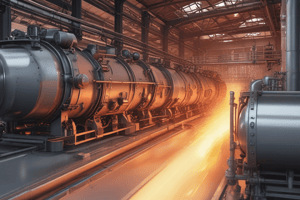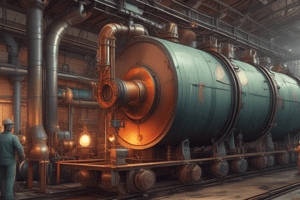Podcast
Questions and Answers
What is the purpose of the low atomizing medium cut-off switch?
What is the purpose of the low atomizing medium cut-off switch?
- To monitor the flame quality
- To extinguish the burner before flame failure occurs (correct)
- To adjust the burner pressure
- To control the UV scanners
How often do UV scanners typically need replacement?
How often do UV scanners typically need replacement?
- Every 5 years
- Every year
- Every 10,000 hours
- Every 40,000 hours (correct)
What can cause a flame scanner to fail sooner than expected?
What can cause a flame scanner to fail sooner than expected?
- High temperature exposure (correct)
- Low temperature exposure
- Inadequate cooling air
- Low fuel pressure
What can happen if a flame rod is incorrectly aligned?
What can happen if a flame rod is incorrectly aligned?
What should be checked during annual burner maintenance concerning flame rods?
What should be checked during annual burner maintenance concerning flame rods?
What can lead to explosive conditions in the furnace when an FD fan fails?
What can lead to explosive conditions in the furnace when an FD fan fails?
What should be done if the combustion air proving switch does not shut down the burner when an FD fan fails?
What should be done if the combustion air proving switch does not shut down the burner when an FD fan fails?
What should be done after repairs are complete when an FD fan failure is determined?
What should be done after repairs are complete when an FD fan failure is determined?
What can cause modern flame amplifiers to fail occasionally?
What can cause modern flame amplifiers to fail occasionally?
When should a certified technician be contacted regarding flame safeguard controls?
When should a certified technician be contacted regarding flame safeguard controls?
Flashcards are hidden until you start studying
Study Notes
Power Failure and Equipment Response
- An electrical power failure requires immediate and effective operator response.
- Operators must be well versed in plant blackout procedures and follow them closely.
- Considerations for responding to a power failure include:
- Control valve failure positions (open, shut, or last)
- Equipment fed by standby power and what is not
- Equipment on uninterrupted power
- Manual starting of standby generators and automatic transfer switches
- Plant load shedding strategies
- Restarting equipment after power is restored
- Sequence of starting equipment after power is restored
Equipment Restart after Power Restoration
- Some equipment will restart automatically when normal power is restored, including:
- Lighting and power receptacles
- Pumps and fans that cycle on or off regularly
- Smaller air compressors, refrigeration compressors, and air dryers
- Equipment that requires manual restart includes:
- Fuel oil pumps
- Boiler feedwater pumps
- Chilled water pumps
- Condenser water pumps
- Boiler draft fans
- Condensate transfer pumps
- Large air compressors
- Refrigeration compressors and chillers
- Air handling unit fans
Valve Failure
- Valves go to a fail-safe position during a power failure.
- Some valves fail open, while others fail shut or closed.
- Control valves fail as follows:
- Heating system control valves fail open
- Fuel line safety shut-off valves fail closed
- Fuel line bleed valves fail open
- Boiler feedwater regulating valves fail closed (unless self-powered)
Plant Response to Power Outage
- Plants without backup power remain "dead" until normal utility power is restored.
- In this case, the operator's job is to put the plant in a safe state until power returns.
- Tasks required in this situation include:
- Monitoring the boiler as it cools down
- Isolating the boiler feed pumps
- Closing the feedwater control valves
- Closing the fuel line test firing valves
- Closing the boiler steam outlet valves
- Opening the boiler non-return valve drain
- Opening the vents and drains on the steam headers
Plants with Emergency Power Supply Systems (EPSS)
- EPSS have backup diesel engines, natural gas engines, or gas turbines operating standby generators.
- The generators are connected to automatic load transfer switches.
- Essential loads are typically:
- Control room panels and instrumentation
- Emergency lighting
- Feedwater control valves
- Fuel control valves
- Boiler feedwater pumps
- Condensate pumps
- Turbine seal oil pumps
- Turbine lubricating oil pumps
- Fire water pumps
Plants with Uninterruptible Power Supply (UPS)
- UPS maintains power to critical equipment through a system of batteries, rectifiers, power inverters, and automatic transfer switches.
- UPS powered equipment is typically short-term, with a battery capacity of up to 6 hours.
- UPS systems are designed for low capacity loads, such as instrumentation and controls, computers, and lighting.
Loss of Water Level
- Causes of a loss of water level include:
- Problem with the feedwater system
- Problem with the boiler
- Feedwater system problems include:
- Pump failure
- Control valve failure
- Failure to return condensate to the plant
- Boiler problems include:
- Boiler blowdown or blowoff valves accidentally left open
- Damaged boiler tubes
- Boiler feedwater pump failure
Boiler Trips on Low Water
- If the cause of low water cannot be determined quickly, and the water level restored, the boiler must trip on low water.
- After it trips, close the pilot and main test firing valves.
- When the boiler stops steaming, close the non-return valve and header valve, and open the non-return valve drain.
- The boiler should not be restarted until the cause of feedwater loss has been rectified.### Flame Failure Signals
- Do not result from boiler permissive actions such as low water cut-off, fuel pressure switch, or pressuretrol.
- Require shutting pilot and main test firing valves, investigating the cause, and testing flame safeguard controls before restoring boiler to service.
Inadequate Pilot Flame
- Can occur if pilot flame is too small to light main burner due to defective or improperly adjusted pilot fuel regulator.
- ASME CSD-1 recommends annual pilot turndown test to establish minimum pilot flame size for safe ignition of main burner.
- Requires certified burner mechanic (Class A gas fitter) to perform test and adjust pilot flame.
Unstable Main Flame Causes
- Excessive fuel pressure
- Inadequate fuel pressure
- Excessive combustion air
- Inadequate atomizing air or steam
- Dirty atomizer spray plate
- Defective fuel pumps
- Blocked fuel strainers
- Utility gas supply failure
Excessive Fuel Pressure Effects
- Causes over-firing, lifting flames, smoky furnace conditions, and flame instability
- Requires adjustment of fuel pressure and high fuel pressure cut-off to manufacturer specifications by certified burner technician, oil fitter, or Class A gas fitter
Inadequate Fuel Pressure Causes
- Improperly adjusted fuel pressure regulator
- Failure in utility fuel supply system
- Blockage in fuel strainer (for oil burners)
- Defective fuel oil pump
- Requires adjustments by certified burner technician, oil fitter, or Class A gas fitter
Studying That Suits You
Use AI to generate personalized quizzes and flashcards to suit your learning preferences.




